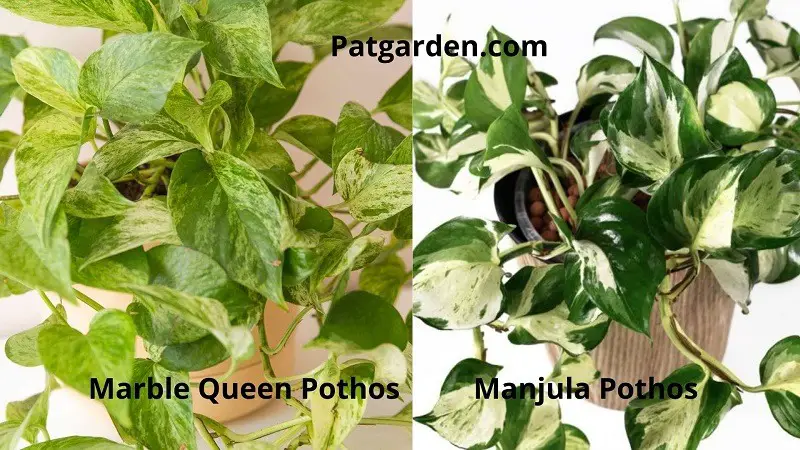When I started my indoor gardening adventure about five years ago, pothos plants were my favorite choice since they are easy to grow and maintain. Besides that, pothos plants come in different variations with distinctive appearances.
Manjula pothos and marble queen are examples of pothos varieties with close similarities. But do not let the leaf shape of these plants deceive you since these pothos plants are indeed different in many ways.
So, what is the main difference between Manjula pothos and marble queen? The Manjula pothos has a waiver and frilly leaves with a swirl of white, gold, and cream patterns. On the other hand, marble queen leaves are broader and flatter speckled in white, cream, and white colors.
Knowing the differences between these pothos varieties will help keep them healthy. This article highlights the differences and similarities between the marble queen and Manjula pothos. So, take the time to read through it before buying one.

Comparison Table (Manjula Pothos Vs Marble Queen)
| Features | Manjula Pothos | Marble Queen |
| Leaf Shape | Wavy and frilly | Broader and flatter |
| Leaf Thickness | Thicker | Thinner |
| Leaf Appearance | Glossy paint appearance | Flat paint appearance |
| Growth Rate | Faster | Slower |
| Variegation | Leaves have swirls of white, yellow, golden, and cream colors. | Leaves are speckled in white, cream, and green paint. |
| Light Requirement | Requires bright indirect sunlight to thrive | Requires direct sunlight. |
| Origin | Developed at the University of Florida. (Sources: Central Florida Research and Education Center) | Native to Southeast Asia, France, Australia, and Polynesia. |
Main Differences between Manjula and Marble Queen
The Manjula pothos and marble queen belong to the same Araceae family. Other family members of these pothos plants are golden pothos, snow queen pothos, neon pothos, and jade pothos.
Marble queen pothos is a parent cultivar of N Joy pothos, pearl, and jade pothos. Both Manjula and marble queen are sold under pothos varieties. Therefore, it can be challenging to make the right choice.
Below are factors to consider when differentiating marble queen and Manjula pothos. Take the time to study these factors to help make an informed decision before purchasing any of these pothos varieties.
Origin
Manjula pothos was discovered and patented by the University of Florida botanists. On the other hand, marble queen pothos hails from Southeast Asia, France, Australia, and Polynesia. Some botanists argue that marble queen pothos originated from Solomon Island.
Leaf Shape
Manjula pothos leaves are smaller, waiver, and frilly, while marble queen leaves are broader and flatter. Besides that, Manjula pothos leaves are smooth, and marble queen leaves are waxy with a soft feeling.
Leaf Variegation
Manjula pothos leaves have swirls of white, golden or light yellow, and cream colors. On the other hand, marble queen leaves are speckled in white, cream, and green colors. The green variegation in marble queen leaves is darker and rich than in Manjula leaves.
Growth Rate
Manjula pothos grows faster with long trails and bushy leaves, while marble queen pothos experiences a slow growth rate. We recommend placing your marble queen in a spot that receives bright indirect sunlight to accelerate the growth.
Internodes Length and Compactness
A Manjula pothos has a short internode length making them ideal as molding plants. On the other hand, marble queen plants have longer internode lengths, making them suitable as trailing plants.
Similarities between Manjula and Marble Queen
Marble queen and Manjula pothos have close similarities despite having distinctive appearances and growth habits. These pothos varieties have heart-shaped leaves with green undersides. Below are other similarities between Manjula pothos and marble queen:
Blooming Habits
Most indoor Manjula pothos and marble queens do not produce flowers. But the outdoor counterpart may produce cylindrical and erected flower stalks that are cream with a purple spathe.
Plant Height and Structure
Indoor marble queens and Manjula pothos have the same height and structure. These pothos varieties can grow up to 6 feet (1.8m) in height with a leaf size of 3 inches in length and 2 inches in width.
Plant Toxicity Level
Marble queen and Manjula pothos have insoluble raphides in their leaves. These mineral compounds are extremely toxic to humans and pets. Ingesting the leaves could result in mouth irritation, vomiting, and swallowing difficulties.
Beautiful Hanging Plants
Both plants have vine-like root systems that allow them to cascade down when grown in hanging planters. The invasive roots can climb a large tree trunk in their native habitat.
Caring and Growing Requirements
Both Manjula pothos and marble queen are similar caring requirements since they belong to the same family. They are resilient and can survive in any climatic condition. We recommend placing them in a spot with bright indirect sunlight and a temperature range of 70-90oF (21-32oC).
Leaf Sheath
Both Manjula pothos and marble queen leaves grow from the vines. The foliage growth phase does not have a sheath.
Common Plant Diseases
These pothos varieties are vulnerable to bacterial leaf spot, rhizoctonia stem rot, and pythium root rot. These conditions may cause leaves to turn yellow, brown, and even plant wilting. We recommend investigating your plant to identify the exact cause and fix it.
Conclusion
Manjula pothos and marble queen are similar despite having distinctive appearances and growing habits. The foliage color, size, texture, and growth rate are crucial factors that help to tell the difference between Manjula pothos and marble queens.
The root systems, growth structure, absence of flowers, and sheath are the features that make it challenging to distinguish between marble queen and Manjula pothos. Besides that, these plants can survive in all conditions by adhering to their growing requirements.
We hope this information will help you make the right choice when buying Manjula pothos or marble queen. Feel free to share your views or suggestions in the comment section and spread the information to your friends or family.
Readers Who Read This Also Read:
